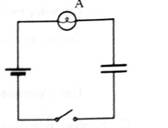

Suppose an uncharged capacitor is connected in series with a battery and bulb as shown.
-
1. Predict the behavior of the bulb when the switch is closed. Explain.
Set up the circuit and check your prediction. If your prediction is in conflict with your observation, how can you account for your observation?
-
2. Without using a voltmeter, determine the potential difference across the capacitor at the following times:
• just after the switch is closed. Explain how you can tell. (Hint: Compare the brightness of the bulb to the brightness of a bulb connected to a battery in a single-bulb circuit without a capacitor.)
• a long time after the switch is closed. Explain how you can tell.
Use a voltmeter to check your predictions. (Hint: Be sure to discharge the capacitor completely after each observation.)
Want to see the full answer?
Check out a sample textbook solution
Chapter 6 Solutions
Tutorials in Introductory Physics
Additional Science Textbook Solutions
Applications and Investigations in Earth Science (9th Edition)
Chemistry: Structure and Properties (2nd Edition)
Campbell Biology in Focus (2nd Edition)
Genetic Analysis: An Integrated Approach (3rd Edition)
Cosmic Perspective Fundamentals
Human Anatomy & Physiology (2nd Edition)
- No chatgpt plsarrow_forward3arrow_forward13. After a gust of wind, an orb weaver spider with a mass of 35 g, hanging on a strand of web of length L = .420 m, undergoes simple harmonic motion (SHO) with an amplitude A and period T. If the spider climbs 12.0 cm up the web without perturbing the oscillation otherwise, what is the period of oscillation, in Hz to three significant figures?arrow_forward
- 15. An object of mass m = 8.10 kg is attached to an ideal spring and allowed to hang in the earth's gravitational field. The spring stretches 23.10 cm before it reaches its equilibrium position. The mass then undergoes simple harmonic motion with an amplitude of 10.5 cm. Calculate the velocity of the mass in m/s at a time t= 1.00s to three significant figures.arrow_forwardplease solve and answer the question correctly. Thank you!!arrow_forward18arrow_forward
- 1. Some 1800 years ago Roman soldiers effectively used slings as deadly weapons. The length of these slings averaged about 81 cm and the lead shot that they used weighed about 30 grams. If in the wind up to a release, the shot rotated around the Roman slinger with a period of .14 seconds. Find the maximum acceleration of the shot before being released in m/s^2 and report it to two significant figures.arrow_forward16arrow_forward11. A small charged plastic ball is vertically above another charged small ball in a frictionless test tube as shown in the figure. The balls are in equilibrium at a distance d= 2.0 cm apart. If the charge on one ball is tripled, find the new equilibrium distance between the balls in cm and report it to the proper number of significant figures.arrow_forward
- 12. The electric field at a point 1.3 cm from a small object points toward the object with a strength of 180,000 N/C. Find the object's charge q, in nC to the proper number of significant figures. k = 1/4πε0 = 8.99 × 10^9 N ∙ m^2/C^2arrow_forward14. When the potential difference between the plates of an ideal air-filled parallel plate capacitor is 35 V, the electric field between the plates has a strength of 670 V/m. If the plate area is 4.0 × 10^-2 m^2, what is the capacitance of this capacitor in pF? (ε0 = 8.85 × 10^-12 C^2/N ∙ m^2)arrow_forward10. A small styrofoam ball of mass 0.500 g is placed in an electric field of 1140 N/C pointing downward. What excess charge must be placed on the ball for it to remain suspended in the field? Report your answer in micro-Coulombs to three significant figures.arrow_forward
 Physics for Scientists and Engineers, Technology ...PhysicsISBN:9781305116399Author:Raymond A. Serway, John W. JewettPublisher:Cengage Learning
Physics for Scientists and Engineers, Technology ...PhysicsISBN:9781305116399Author:Raymond A. Serway, John W. JewettPublisher:Cengage Learning College PhysicsPhysicsISBN:9781938168000Author:Paul Peter Urone, Roger HinrichsPublisher:OpenStax College
College PhysicsPhysicsISBN:9781938168000Author:Paul Peter Urone, Roger HinrichsPublisher:OpenStax College
 Physics for Scientists and Engineers: Foundations...PhysicsISBN:9781133939146Author:Katz, Debora M.Publisher:Cengage Learning
Physics for Scientists and Engineers: Foundations...PhysicsISBN:9781133939146Author:Katz, Debora M.Publisher:Cengage Learning
 Physics for Scientists and Engineers with Modern ...PhysicsISBN:9781337553292Author:Raymond A. Serway, John W. JewettPublisher:Cengage Learning
Physics for Scientists and Engineers with Modern ...PhysicsISBN:9781337553292Author:Raymond A. Serway, John W. JewettPublisher:Cengage Learning





